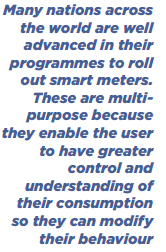Smart energy relies on Internet of Things (IoT) technologies to change the consumption habits of users and enable energy providers to gain efficiencies while boosting their environmental credentials, writes Emmanuel Maçon-Dauxerre.
With Navigant Research reporting that global smart energy for smart cities technology revenue is expected to grow from $7.3 billion in 2015 to $20.9 billion in 2024 and ABI Research estimating that smart meter rollouts, led by energy and water utilities, will result in a global installed base of more than 1.1 billion smart meters within the next five years, it’s clear that the smart energy concept is emerging into a market reality.
Smart energy encompasses the entire energy supply chain, ensuring the right amount of energy is generated to meet demand and fuel isn’t wasted by creating oversupply. To achieve this a greater understanding of the consumption profiles of users is needed and this goes hand-inhand with a new approach to energy pricing which will see a move a way from the traditional fee per unit model that has served the industry for decades.
Instead of that, we will see pricing based on peak demand emerge so users are incentivised to run washing machines or charge their electric cars at off-peak times. Using such methods to flatten out peaks and troughs in demand will integrate well with the often-bursty nature of energy supply generated from renewables.
The variables involved make this a much more complex industry than the traditional energy supply market which simply piped gas to your home or brought electricity from the local power station to your premises via a cable. Now, each home may be a net producer of energy and sell energy back to the grid during the day but require energy from the grid to handle the power load of charging two electric cars ready for the morning commute.
Applying intelligence
Smarts therefore are needed to gather, collate and analyse all the data. Smart grids, which will help ensure supply remains available, will handle some of this but as you get closer to the point of use, grid data is less valuable as the individual demands of customers need to be addressed. What energy providers need is a clear picture of the needs of the user and the capabilities of their home’s system and this is where the role of smart meters becomes significant.
 Many nations across the world are well advanced in their programmes to roll out smart meters. These are multi-purpose because they enable the user to have greater control and understanding of their consumption so they can modify their behaviour, perhaps turning to IoT to enable smart thermostats or other home automation apps. In this way they can help users save consumption and thereby save money.
Many nations across the world are well advanced in their programmes to roll out smart meters. These are multi-purpose because they enable the user to have greater control and understanding of their consumption so they can modify their behaviour, perhaps turning to IoT to enable smart thermostats or other home automation apps. In this way they can help users save consumption and thereby save money.
In addition, such meters can be used to help energy providers plan. They can use smart meter data to bill accurately for consumption but also to ensure they scale energy availability to meet specific demand profiles.
The value of data
As energy suppliers move away from the actual supply of energy being their key source of profit, the data that users generate provides a means for them to provide a range of value-added services and applications to users – naturally for a fee. This incremental additional revenue will be critical in offsetting lost profitability from the core, traditional business. We could see energy providers offer home management apps to control temperatures or switch off appliances when consumers are absent. This greater control will be vital for enabling users to take advantage of more flexible pricing. Setting washing machines to run in the night is the classic example but new use cases such as charging devices and vehicles are emerging.
Why smart meters really count
To achieve the smart energy benefits, reliable connections to smart meters are required. It is too complex for smart meters to rely on home Wi-Fi since this will require millions of meters to be integrated to constantly changing domestic broadband providers. In addition, being in control of the connection enables meter owners to have greater control of the data and services.
To keep this control and manage the costs of smart meter deployments, energy firms are relying on wireless technologies to support smart meters. More and more deployments utilise cellular networks because of the coverage available but there are instances of smart meter projects using narrow band wireless connections.
It is unclear currently what future bandwidth needs smart meters may require. Today, they are relatively limited since sharing lines of data with a centralised data hub is not a challenging amount of data for even a 2G cellular network connection to transmit. However, as apps become richer, there is a strong likelihood that higher throughputs may be required.
Regulation drives adoption
Although there is clear interest in managing energy consumption more efficiently among consumers and enterprises, the scale and scope of smart energy projects should not be underestimated. There are billions upon billions of meters in the world, all of which will require updating. Governments and regulators see smart meters as a means to meet their environmental goals and in many regions smart meter deployment is already mandated for new construction and scheduled for retrofit environments.
This is creating momentum across the smart energy sector. With government-legislated smart meter deployments set, providers need to address how to generate revenue from their investment in smart meters. A virtuous circle is being created in which enforced smart meter investment creates a greater need for smart energy apps that will create new sources of revenue, thereby eventually making the business case for smart meters appealing.
The dawn of smart energy is here and, while there is a long way to go to maturity, a stable of tried and tested technologies exists from the meters, through the connectivity to the data analytics applications. A greater range of attractive consumer-oriented applications is required to truly deliver on the promise that smart energy holds of enabling companies to make money from smart energy. In addition, energy suppliers need to become more dynamic in their utilisation of smart meter functionality to enable new business models, pricing and services. However, when more innovation hits the market and the installed base of smart meters grows further, smart energy projects will really start to hit prime time.










